Recent Comments
No comments to show.
Posted by admin in Attachment Parenting, Babies 0-6 months, Breastfeeding, Safety, Sleep on January 23rd, 2017
Scientists have identified a possible biological cause for SIDS (Sudden Infant Death Syndrome) that was never known before. There has been a recent breakthrough in research into SIDS with results that could help prevent even more of these tragic deaths. SIDS is defined as the unexplained death of a seemingly healthy infant under 12 months of age. There has been extensive research and awareness campaigns conducted around the world over the last 20 years that have resulted in an 80% reduction in SIDS deaths. However, last year there were still 113 infant and newborn SIDS deaths. The aim is for that number to be 0.
Scientists at The Children’s Hospital at Westmead, have discovered that babies who die from SIDS are deficient in a protein called Orexin. This protein is responsible for regulating sleep arousal in babies and adults. A cohort study of more than 27 SIDS cases and 19 controls found the level of Orexin was 20 per cent lower in the brains of those babies who had died from SIDS. What this means is that the message to wake up may not be getting through to babies’ brains.
Associate Professor Alexandra Martiniuk from The George Institute for Global Health at the University of Sydney says that the study found it was the Orexin deficiency along with environmental factors that resulted in the deaths. She stated that in most cases of SIDS related deaths, the baby was found either face down or with their head between the mattress and something else. The conclusions were that in most cases Orexin deficiency along with other factors resulted in the deaths. The discovery of this protein deficiency may be able to help health professionals identify babies at greater risk of SIDS. They hope to have a screening test within 10 years.
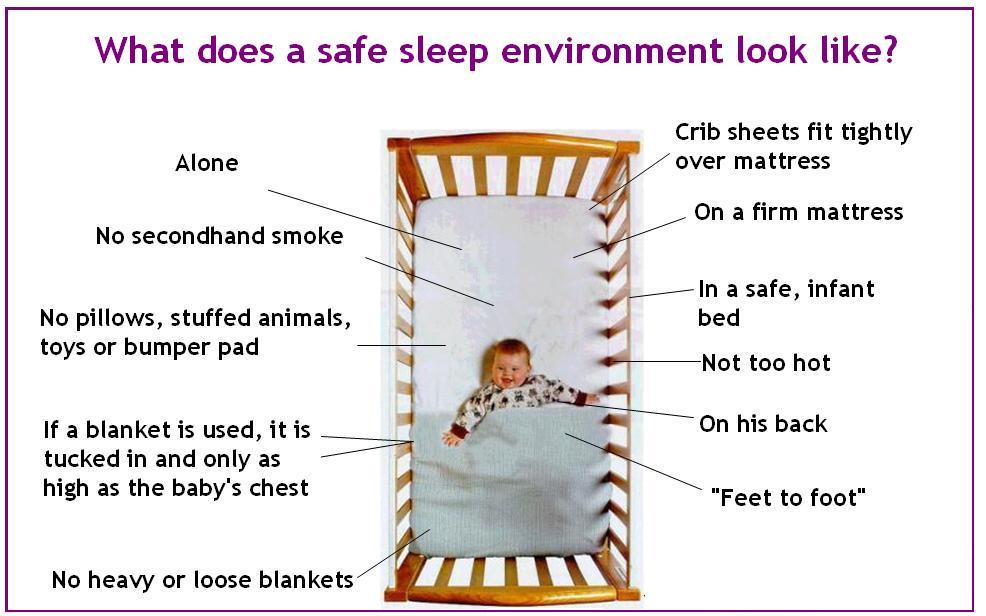
What the researchers and SIDS experts do emphasize is the need for all parents and carers to follow safe sleep practice guidelines. This is still considered the best method of preventing SIDS. The research may also have significant implications for how parents choose sleeping arrangements for their baby. Many parents are choosing co-sleeping arrangements these days with very positive outcomes. Research into these practices has found that when babies are in the same room as parents then the parent often wakes up when there is an adverse event. However, it is still recommended that babies under 3 months sleep on their own surface.
An excellent method for addressing both issues is by using a co-sleeper bassinet. A cosleeper is a baby bed that can securely attach to the parents bed, meaning both parent and baby have their own sleep surface but baby is easily accessible for nighttime cuddles, feeds and settling and can wake and see and smell his or her parents.
As a former Neonatal ICU nurse specialist, I am particularly focused on the health and safety of vulnerable babies. While it is great to have a test to see which babies will be most vulnerable to SIDS, its vitally important to continue safe sleeping practices. Those guidelines are listed by www.rednose.com.au and recommended by all medical experts and midwives. They include:
Emma Hutton RN Post Grad. Cert. NICU
Owner Rock-A-Bye Baby Hire (North Branch)
www.rockabyebabyhire.com.au
Posted by admin in Attachment Parenting, Babies 0-6 months, Babies 6 months - 4 years, How to, Safety, Sleep on July 21st, 2015
Infant sleeping bags can be a great option for babies as they eliminate the need for any extra bedding and for babies who roll around lots in bed it means they can’t get completely uncovered and cold. Sleeping bags also eliminate the need for lots of bedding which can become a suffocation risk in bed.
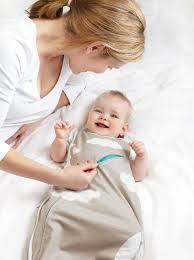
However, some baby sleeping bags on the market – particularly but not limited to those sold overseas and on online auction sites – have hoods despite hoods posing a significant safety risk to babies.
Hooded sleeping bags can potentially cover a baby’s face while they sleep, increasing the risk of suffocation significantly.
Posted by admin in Attachment Parenting, Babies 0-6 months, Babies 6 months - 4 years, How to, Sleep on July 19th, 2015
So, you’ve painted the nursery, bought the pram, set up the cot and are ready for baby to come home. Its very important to understand and follow the safe sleep guidelines to keep your baby sleeping safely day and night.
The guidelines for making up your baby’s cot have been prepared by SIDS and Kids and are a set of simple easy to follow recommendations to reduce the SIDS risk. SIDS and Kids Safe Sleeping is an evidence-based health promotion campaign developed for health professionals, childcare workers, new and expectant mothers, parents and anyone who cares for babies and infants. Since its inception in the early 1990s, the Safe Sleep campaign has reduced the incidence of Sudden Unexpected Death in Infancy by 80% saving 8,480 babies’ lives.
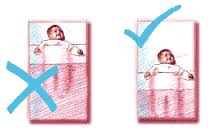
For more information on Safe Sleep please visit SIDS and Kids.
Posted by admin in Attachment Parenting, Babies 0-6 months, Breastfeeding, How to, Safety, Sleep on July 17th, 2015
When you are becoming a parent you’ll often find yourself bombarded with lots of information – some helpful, some not so much so. One of the things as a parent you will need to learn about are how to put your baby to bed safely. SIDS (Sudden Infant Death Syndrome) is a genuine concern for all parents and at present the cause of SIDS remains unknown.
For some time there was a theory that there may be a link between SIDS events and the bacteria Staphylococcus aureus (S. aureus) which can be present in baby’s bed mattresses. SIDS and Kids has reviewed the research to date and has found that there is no evidence to show that there is an increased risk of SIDS for babies who sleep on the back and on a firm, clean, well fitting mattress that is in good condition. There is no reason for you to buy a brand new mattress for every baby if the mattress you have or are hiring is clean, firm, it fits the bed its being used in well without any gaps it is perfectly safe.
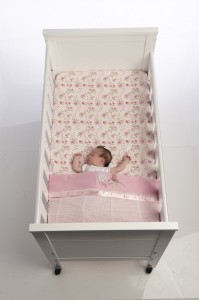
A complete copy of the Information Statement can be found by following this link to the SIDS and Kids Website.
Posted by admin in Attachment Parenting, Babies 0-6 months, Crying, General, Pregnancy, Sleep on April 21st, 2015
For normal, healthy infants crying is a very common occurrence, especially during the first 12 weeks of life. Between 2 and 6 weeks of age a baby’s crying steadily increases and can put a lot of strain on parents, making you feel stress, anxious, angry, upset or just helpless. All babies do go through this period of crying and it can vary in intensity. Much like height or weight, some babies are taller or heavier while others are shorter, some babies cry a great deal, others not so much.
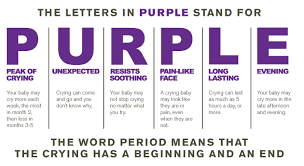
The Period of PURPLE Crying is a concept developed by Dr. Ronald Barr, MCDM, FRCPC, as a way to educate new parents about normal crying behavior and its place in normal child development. The concept of PURPLE Crying is based on almost 50 years of early infant development and crying research by an international cast of scientist and pediatricians. Related studies were done on non-mammalian (breast feeding) species, like chimpanzees, and found that their babies have a similar crying curve. Crying is a normal part of child development.
The acronym PURPLE is used to describe specific characteristics of a baby’s crying during this period. Its important to know that what you are experiencing is quite normal and, although frustrating, is simply a phase in your baby’s development – and it will pass. The word Period is important because it tells parents that it is only temporary and it will come to an end.
When you are feeling frustrated, angry or upset it’s OK to walk away and take a break from the crying. Put your baby in a safe spot (their cot, a rocker or perhaps a pram) and step out of the room, perhaps to a space where you can no longer hear the crying and take a few minutes for yourself, walk around, have a cool glass of water or put the kettle on. The time you spend away from the crying can help you calm down, so you’ll be better able to handle the situation when you come back – even if your baby keeps crying they’ll be fine.
Even when you are at your wits-end, remember its just a phase, crying is normal and you’re doing fine.
Posted by admin in Attachment Parenting, Babies 0-6 months, Babies 6 months - 4 years, General, Sleep on March 18th, 2015
I remember the disturbed sleep was the hardest part about being a new Mum. I was shocked! What’s this? Broken sleep nearly broke me and I got to the point where I was exhausted. It did end, finally, when my daughter was about 12 months old and the wake ups slowed right down to just once a night and sometimes not at all.
It should be said that broken sleep and babies waking regularly during the night is completely normal.
You haven’t done anything wrong, and neither has your baby. Its normal.
It might help you to know that “sleeping through” means 5 hours of straight sleep, not 8 or 10 (sorry!).
For many parents and caregivers, even if you don’t have to get up to go to work in the morning, the question you will ask yourself more than any other may well be will this baby ever sleep through the night?
The answer is yes – sort of. The truth is, few babies truly ‘sleep through the night’ in the same way an adult does. In fact, sleep researchers have found that little people under 12 months old will normally wake up an average of three times during the night. For the first few months of life, 95% of babies will cry when they wake up and they’ll mostly want some help from you getting back to sleep. But eventually, they’ll learn to just nod back off to sleep on their own.

Several studies have found that by eight months old, over 50% of infants who wake at night go back to sleep without any attention from parents or other caregivers. In fact, sometimes their parents didn’t even realise they’d been awake.
All babies are individuals, and sleep patterns vary greatly from child to child. Even though typical sleep patterns don’t apply to all babies, researchers have identified general patterns that you can look for as your child gets older.
Sleep for newborn to six months
It might seem hard to believe when you don’t get enough sleep yourself, but wee babies sleep around 18 hours a day. It’s also ok if yours sleeps more than that, or less than that. Generally speaking little babies will sleep in batches of a few hours at a time, between 2 and 4 then wake for short periods (quick feed, change, cuddle and back off to sleep). The pattern may vary and change somewhat, and it does go on around the clock. A newborn doesn’t know that people sleep when it’s dark, and a baby’s ‘circadian rhythm’ – the 24-hour internal clock that controls our sleeping and waking patterns – is still developing.

By around six months of age, babies may have their big sleep at night and have some pattern with darkness and light. At six months, your baby will probably still wake a few times a night, and that’s ok.
Researchers using video recording in nurseries found that babies vary a lot when it comes to waking and crying – or not crying – at night. They found the biggest changes in infants’ sleeping and waking patterns happen between three and six months. Six-month-olds sleep longer at a stretch than three-month-olds. They’re also more likely to go back to sleep on their own when they wake.
There are so many wonderful changes in babies during the first 12 months. Sleep is one of them, as babies develop more adult-like sleep patterns, so hang in there. Sleep is on the way.
If you’ve never had a period of bad sleeping before, you might get a shock at just how much lack of sleep can affect your life. It’s important you still look after yourself during this time, and try to get the sleep you need to feel rested. So leave the housework, rest when your baby does, catch a lie down together when you feed and accept all offers of help from friends and family.
baby sleep, baby sleeping through the night, how to get baby to sleep, normal baby sleep, sleeping through
